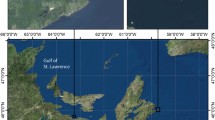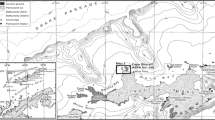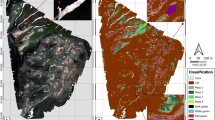Abstract
We examined the movement patterns of American Coots relative to water temperature and heat index where a geothermally heated stream enters Utah Lake, UT, USA during winter using a thermal imager onboard an Unmanned Aerial System (UAS). Observations of Coots in different water temperatures (n = 2354) were compiled during 31 flights in January–March, 2020. Coots were actively swimming during 82.3% of the observations, fleeing during 8.1%, and sedentary in water during 9.6%. The population spent more time swimming in cooler water and were sedentary for longer in warmer water. The only instance of uniform behavior occurred during an anomalously cold period in which Coots stood huddled in the warmest available water. Using a linear model framework, we found that Coot time spent increased with water temperature when heat index decreased. Coots’ swim paths deviated away from warmer water more than cooler water and more so as heat index increased. We suggest that Coots use the spring water primarily for ice-free habitat and maintain metabolic rates via a combination of thermal conductance, caloric ingestion, and exercise, but only exploit the heated water strictly for thermoregulation during anomalously cold periods. We discuss the benefits and hindrances of using UASs amidst a rapidly expanding assortment of sensors and aircraft available to researchers. Given wetlands’ immediate conservation concern, ecosystem services they provide, and support of unique species assemblages, our research provides valuable insight into documenting wildlife’s use of wetlands with relatively low scientific take and human interference.





Similar content being viewed by others
Data availability
Data are available upon request from the corresponding author.
References
Abadie A, Susan A, Guido WI, Wooldridge JM (2023) When should you adjust standard errors for clustering? Q J Econ 138(1):1–35
Arnold TW (1990) Food limitation and the adaptive significance of clutch size in American Coots (Fulica americana). Doctoral dissertation, University of Western Ontario
Aydin B (2019) Public acceptance of drones: knowledge, attitudes, and practice. Technol Soc 59(1):101180
Barr JR, Green MC, DeMaso SJ, Hardy TB (2020) Drone surveys do not increase colony-wide flight behaviour at waterbird nesting sites, but sensitivity varies among species. Sci Rep 10(1):1–10
Batchelder CF (1881) The Bald Eagle (Haliaëtus leucocephalus) as a Hunter. Bull Nuttall Ornithol Club 6(1):58–60
Benedict RJ, Hepp GR (2000) Wintering waterbird use of two aquatic plant habitats in a southern reservoir. J Wild Manag 64(1):269–278
Benjamin S (2017) Use of drones in Avian conservation: exploring the use of commercially available drones in wetlands shorebird population monitoring. Master’s Thesis, Johns Hopkins University
Bent AC (1926) Life histories of North American marsh birds: orders Odontoglossae, Herodiones and Paludicolae. US Natl Mus Bull 135:1–490
Blackett RE, Wakefield SI (2002) Geothermal resources of Utah: a digital Atlas of Utah’s geothermal resources. Utah Geological Survey, Utah, pp 1–95
Bortolotti GR, Hobson KA, Butt UJ, Surai PF (2009) Influence of diet on egg size in american Coots (Fulica americana): evidence from food supplementation and biochemical markers. Auk 126(4):831–838
Bouchard LC, Anderson MJ (2011) Caribbean Flamingo resting behavior and the influence of weather variables. J Ornithol 152(2):307–312
Boyer T, Polasky S (2004) Valuing urban wetlands: a review of non-market valuation studies. Wetlands 24(4):744–755
Carr JM, Lima SL (2012) Heat–conserving postures hinder escape: a thermoregulation-predation trade-off in wintering birds. Behav Ecol 23(2):434–441
Chabot D, Bird DM (2015) Wildlife research and management methods in the 21st century: where do unmanned aircraft fit in? J Unmanned Veh Syst 3(4):137–155
Coombs RE (1970) Aquatic and semi-aquatic plant communities of Utah Lake. Doctoral Dissertation, Brigham Young University
R Core Project (2021) The R Project for Statistical Computing. http://wwwR–projectorg/. Accessed 30 Apr 2021
Davidson NC (2014) How much wetland has the world lost? Long-term and recent trends in global wetland area. Mar Freshw Res 65(10):934–941
Dronova I, Kislik C, Dinh Z, Kelly M (2021) A review of unoccupied aerial vehicle use in Wetland Applications: Emerging Opportunities in Approach, Technology, and data. Drones 5(2):45–74
eBird (2022) eBird: An online database of bird distribution and abundance. Cornell Lab of Ornithology, Ithaca, New York. https://ebird.org/species/y00475. Accessed 27 January 2022
Eddleman WR, Patterson CT, Knopf FL (1985) Interspecific relationships between american Coots and waterfowl during fall migration. Wilson Bull 97(4):463–472
Ehrenfeld JG (2000) Evaluating wetlands within an urban context. Urban Ecosyst 4(1):69–85
Ehrlich P, Dobkin DS, Wheye D (1988) Birder’s handbook: a field guide to the natural history of North American Birds. Simon and Schuster, New York
Fitzner RE, Schreckhise RG (1979) The american coot (Fulica americana). On the Hanford Site. Part 1: Nesting Biology, PNL-2462, Pacific Northwest National Lab. Richland, Washington, pp 1–30
Fortin D, Gauthier G, Larochelle J (2000) Body temperature and resting behavior of greater snow goose goslings in the high Arctic. Condor 102(1):163–171
Francis RJ, Lyons MB, Kingsford RT, Brandis KJ (2020) Counting mixed breeding aggregations of animal species using drones: lessons from waterbirds on semi-automation. Remote Sens 12(7):1185–1202
Fredrickson LH (1970) Breeding biology of american coots in Iowa. Wilson Bull 82(1):445–457
Gardner RC, Finlayson C (2018) Global wetland outlook: state of the World’s wetlands and their services to people. Secretariat of the Ramsar Convention, Gland, Switzerland, pp 2020–2025
Gerstell R (1939) Certain mechanics of winter quail losses revealed by laboratory experimentation. Trans North Am Wildl Conf 4(1):462–467
Gilbert C, Blanc S, Le Maho Y, Ancel A (2008) Energy saving processes in huddling emperor penguins: from experiments to theory. J Exp Biol 211(1):1–8
Gilbert C, McCafferty D, Le Maho Y, Martrette JM, Giroud S, Blanc S, Ancel A (2009) One for all and all for one: the energetic benefits of huddling in endotherms. Biol Rev 85(3):545–569
Goldstein DL (1983) Effect of wind on avian metabolic rate with particular reference to Gambel’s quail. Physiol Zool 56(4):485–492
Harvey MC, Hare DK, Hackman A, Davenport G, Haynes AB, Helton A, Briggs MA (2019) Evaluation of stream and wetland restoration using UAS-based thermal infrared mapping. Water 11(8):1568–1581
Hillmann ER, La Peyre MK (2019) Effects of salinity and light on growth and interspecific interactions between Myriophyllum spicatum L. and Ruppia maritima L. Aquat Bot 155(1):25–31
Hohtola E, Rintamäki H, Hissa R (1980) Shivering and ptiloerection as complementary cold defense responses in the pigeon during sleep and wakefulness. J Comp Physiol 136(1):77–81
Irwin S, O’Halloran J (1997) The wintering behaviour of coot Fulica atra L. at Cork Lough, south-west Ireland. Biol Environ Proc R Irish Acad 97B:157–162
Jeziorska J (2019) UAS for wetland mapping and hydrological modeling. Remote Sens 11(17):1997–2036
Johnston DW (2019) Unoccupied aircraft systems in marine science and conservation. Ann Rev Mar Sci 11(1):439–463
Jones JC (1940) Food Habits of the american coot with notes on distribution. US Department of the Interior. Wildl Res Bull 2(1):1–52
Krausman PR (1999) Some basic principles of habitat use. In: Launchbaugh KL, Sanders KD, Mosley JC (eds) Grazing Behavior of Livestock and Wildlife. Idaho Forest, Wildlife, and Range Experiment Station Bulletin, No. 70, Moscow, Idaho, pp 85–90
Lachman D, Conway C, Vierling K, Matthews T (2020) Drones provide a better method to find nests and estimate nest survival for colonial waterbirds: a demonstration with western grebes. Wetl Ecol Manag 28(5):837–845
Langhammer J (2019) UAV monitoring of stream restorations. Hydrology 6(2):29–51
Lasfar S, Monette F, Millette L, Azzouz A (2007) Intrinsic growth rate: a new approach to evaluate the effects of temperature, photoperiod and phosphorus–nitrogen concentrations on duckweed growth under controlled eutrophication. Water Res 41(11):2333–2340
Luniak M (2004) Synurbanization—adaptation of animal wildlife to urban development. In: Shaw WW, Harris LK, Vandruff L (eds) Proceedings of the 4th International Urban Wildlife Symposium. University of Arizona, Tucson, pp 50–55
Manfreda S, McCabe MF, Miller PE, Lucas R, Madrigal PV, Mallinis G, Ben Dor E, Helman D, Estes L, Ciraolo G et al (2018) On the use of unmanned aerial systems for environmental monitoring. Remote Sens 10(4):641–669
Manly BF, McDonald L, Thomas DL, McDonald TL, Erickson WP (2002) Resource selection by animals. Statistical design and analysis for field studies. Springer, Berlin
Marco-Mendez C, Ferrero-Vicente LM, Heck KL Jr (2020) Feeding preference and foraging impact of wintering coots on submerged aquatic vegetation. Estuar Coast Shelf Sci 235:106575
McKellar AE, Shephard NG, Chabot D (2021) Dual visible-thermal camera approach facilitates drone surveys of colonial marshbirds. Remote Sens Ecol Conserv 7(2):214–226
McKnight SK, Hepp GR (1998) Foraging-niche dynamics of gadwalls and american Coots in winter. Auk 115(3):670–683
Merritt LV (2017) Utah Lake: A Few Considerations Wasatch Front Water Quality Council. http://wfwqc.org. Accessed 18 November 2022
Millennium Ecosystem Assessment (2005) Ecosystems and human well-being: wetlands and water. Island Press, Washington, pp 1–80
Mitsch WJ, Bernal B, Hernandez ME (2015) Ecosystem services of wetlands. Int J Biodivers Sci Ecosyst Serv Manag 11(1):1–4
Munday C, Rose P (2022) Environmental and social influences on the behaviour of free-living mandarin ducks in Richmond Park. Animals 12(19):2554–2572
Palta MM, Grimm NB, Groffman PM (2017) Accidental urban wetlands: ecosystem functions in unexpected places. Front Ecol Environ 15(5):248–256
Paullin DG (1987) Cannibalism in American Coots induced by severe spring weather and avian cholera. Condor 89(2):442–443
Pöysä H, Kotilainen J, Väänänen VM, Kunnasranta M (2018) Estimating production in ducks: a comparison between ground surveys and unmanned aircraft surveys. Eur J Wildl Res 64(6):1–4
Richter S, Gerum RC, Schneider W, Fabry B, Le Bohec C, Zitterbart DP (2018) A remote-controlled observatory for behavioural and ecological research: a case study on emperor penguins. Methods Ecol Evol 9(5):1168–1178
Rothfusz LP (1990) The heat Index equation (or, more than you ever wanted to know about heat index). US National Weather Service, Fort Worth
Ryeland J, Weston MA, Symonds MR (2021) The importance of wetland margin microhabitat mosaics; the case of shorebirds and thermoregulation. J Appl Ecol 58(2):382–391
Scherer NM, Gibbons HL, Stoops KB, Muller M (1995) Phosphorus loading of an urban lake by bird droppings. Lake Reserv Manag 11(4):317–327
Singh SP, Singh P (2015) Effect of temperature and light on the growth of algae species: a review. Renew Sust Energy Rev 50(1):431–444
Steen I, Steen JB (1965) The importance of the legs in the thermoregulation of birds. Acta Physiol Scand 63(3):285–291
Sutter GC (1988) Development of homeothermy in the American coot (Fulica americana): thermoregulatory patterns in air and water. Master’s thesis, University of Manitoba
Sutter GC, Macarthur RA (1989) Beta-adrenergic sensitivity in juvenile american coots (Fulica americana): evidence of nonshivering thermogenesis? Comp Biochem Physiol C Pharmacol 93(1):105–110
Thomas SM, Verhoeven MR, Walsh JR, Larkin DJ, Hansen GJ (2021) Species distribution models for invasive eurasian watermilfoil highlight the importance of data quality and limitations of discrimination accuracy metrics. Ecol Evol 11(18):12567–12582
Tickner D, Opperman JJ, Abell R, Acreman M, Arthington AH, Bunn SE, Young L (2020) Bending the curve of global freshwater biodiversity loss: an emergency recovery plan. Bioscience 70(4):330–342
Traut AH, Hostetler ME (2003) Urban lakes and waterbirds: effects of development on avian behavior. Waterbirds 26(3):290–302
Trenchard H (2013) American coot collective on-water dynamics. Nonlinear Dyn Psychol Life Sci 17(2):183–203
United States Department of Defense (2021) Department Guidance on Procurement and Operation of DoD Unmanned Aircraft Systems. https://www.defense.gov/News/Releases/Release/Article/2770897/department-guidance-on-procurement-and-operation-of-dod-unmanned-aircraft-syste/. Accessed 25 November 2022
United States Federal Aviation Administration (2011) Unmanned Aircraft Operations in the National Airspace System (NAS). Federal Aviation Administration Air Traffic Organization Policy Notice N JO 7210766; US Dept of Transportation: Washington, DC, pp 1–12
Van Sant MJ, Bakken GS (2006) Thermoregulation on the air-`water interface: foot conductance, activity metabolism and a two-dimensional heat transfer model. J Therm Biol 31(6):491–500
Wakefield ED, Phillips RA, Matthiopoulos J (2009) Quantifying habitat use and preferences of pelagic seabirds using individual movement data: a review. Mar Ecol Prog Ser 391(1):165–182
Watts AC, Ambrosia VG, Hinkley EA (2012) Unmanned aircraft systems in remote sensing and scientific research: classification and considerations of use. Remote Sens 4(6):1671–1692
Wilson RP (2002) Movements in Adélie Penguins foraging for chicks at Ardley Island, Antarctica: circles within spirals, wheels within wheels. Polar Biosci 1(15):75–87
Zuur AF, Ieno EN, Elphick CS (2010) A protocol for data exploration to avoid common statistical problems. Methods ecol evol 1(1):3–14
Acknowledgements
We are grateful to the Saratoga Springs Police Department for their logistical assistance, as well as to D. Nelson and the field technicians who supported this effort. We also thank the anonymous reviewers for their contributions in improving this article.
Funding
The authors have no funding to declare.
Author information
Authors and Affiliations
Contributions
Conceptualization: JHW; methodology: JHW; formal Analysis and investigation: CSP, JHW; writing—original draft preparation: JHW, CSP. Visualization: JHW, CSP, LBC.
Corresponding author
Ethics declarations
Conflicts of interest
The authors declare no conflicts of interest.
Ethical approval
This research was permitted of the Utah Department of Natural Resources Division of Wildlife Resources.
Additional information
Publisher’s Note
Springer Nature remains neutral with regard to jurisdictional claims in published maps and institutional affiliations.
The views expressed in this article are those of the author and do not necessarily reflect the official policy or position of the United States Air Force Academy, the United States Air Force, the Department of Defense, or the United States Government.
Supplementary Information
Below is the link to the electronic supplementary material.
Rights and permissions
About this article
Cite this article
White, J.H., Philipps, C.S. & Chandler, L.B. Using airborne thermal imaging to understand American Coot movement patterns in a hot spring refugium during winter. Wetlands Ecol Manage 31, 875–886 (2023). https://doi.org/10.1007/s11273-023-09957-w
Received:
Accepted:
Published:
Issue Date:
DOI: https://doi.org/10.1007/s11273-023-09957-w




